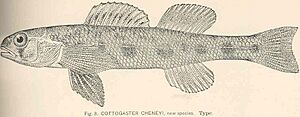Channel darter facts for kids
Quick facts for kids Channel darter |
|
|---|---|
 |
|
| Conservation status | |
| Scientific classification | |
| Synonyms | |
|
The channel darter (Percina copelandi) is a small freshwater fish. It's a type of "darter," which belongs to the same fish family as perch and pikeperch.
This fish lives in North America. You can usually find it in shallow, sandy or gravelly parts of lakes. It also lives in small and medium rivers, especially where the water flows quickly over sand, gravel, or rocks.
Channel darters are small, growing to about 34 to 72 millimeters (1 to 3 inches) long. They are olive-brown with darker spots. Sometimes they have a dark spot below their eye and dark blotches along their sides. They mostly eat tiny insect larvae and other small creatures. They lay their eggs in small streams.
In Canada, this fish is listed as threatened. However, across its whole range, it is considered a "least concern species" by the International Union for Conservation of Nature. This means it is not currently at high risk of disappearing.
Contents
What Does It Look Like?
The channel darter is a small fish. It usually grows to be between 34 and 61 millimeters long. Some can even reach 72 millimeters.
Its body is light sand or olive in color. It has brown speckles on its back. You might see a dark spot or line below its eye, extending to its snout. It also has 8 to 18 brown blotches along its sides, connected by a thin brown line.
When male darters are ready to lay eggs, their heads turn dark. Their fins are usually clear or have light speckles. The first fin on their back often has 11 rays, which are like little support bones.
How to Tell It Apart from Other Darters
The channel darter looks a lot like the river darter. But you can tell it apart from the johnny darter and the tessellated darter. Those two fish only have one spine on their anal fin, while the channel darter has two.
It also differs from the blackside darter. The channel darter usually has 11 rays on its first spiny dorsal fin. The blackside darter typically has 13 to 14 rays.
Where Do Channel Darters Live?
This fish is native to North America. It lives in many different places, but its populations can be spread out.
In Canada, the channel darter is not very common. You can find separate groups of them in Ontario and Quebec. In Ontario, they live in Little Rideau Creek and in rivers that flow into the Bay of Quinte. They are also found in Lake Erie and Lake St. Clair. Along the Huron-Erie corridor, they have been found in the St. Clair and Detroit Rivers. In Quebec, they live in some rivers that flow into the St. Lawrence and Ottawa Rivers.
In the United States, the channel darter is more common. It lives in the Ohio River basin and the lower Mississippi River basin.
Habitat and Life Cycle
Channel darters like to live in pools and fast-flowing areas of small to medium-sized rivers. They can also be found in shallow parts of large rivers where the current is slow. They prefer bottoms made of sand, gravel, or rock.
You might also find these fish in lakes. They live along sandy and gravelly beaches where the waves are gentle and the water moves slowly.
Reproduction
Channel darters lay their eggs together in spring and early summer. This happens in upstream areas where the water flows moderately fast. They choose spots with fine gravel or small rocks.
Male darters set up special areas for breeding. Females lay eggs with different males. Each time, they lay 4 to 10 eggs in a "nest." A female can lay between 350 and 700 eggs in total. After the eggs are laid, the parents do not take care of them.
What Do Channel Darters Eat?
The channel darter is a "benthic feeder." This means it eats food that lives on the bottom of the river or lake. They mostly eat insect larvae, like mayfly and midge larvae. They also eat algae and tiny bits of decaying plants and animals.
Protecting Channel Darters
In some areas, channel darters are at risk. Their homes can be harmed by too much dirt and sand in the water. This often comes from farming and city growth. Dirty water from these activities also hurts them.
Activities that stop or slow down water flow during the time they lay eggs are also a threat. This can make it hard for them to reproduce.
Another problem is an introduced fish called the round goby. This fish might compete with channel darters for food and space. Round gobies could also eat channel darter eggs.
However, overall, the channel darter lives in a wide area. It has a large total population with many smaller groups. No major threats have been found across its entire range. Because of this, the International Union for Conservation of Nature has listed it as a "least concern species."
How It Got Its Name
The channel darter was first officially described in 1877. It was named Rheocrypta copelandi by an American zoologist named David Starr Jordan. He found it in the White River in Indiana.
Its scientific name, copelandi, honors another American zoologist, Herbert Edson Copeland.


